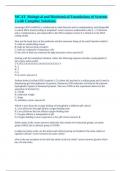Exam (elaborations)
MCAT- Biological and Biochemical Foundations of Systems || with Complete Solutions.
- Course
- Institution
messenger RNA (mRNA) is synthesized in what direction and is complementary and antiparallel to which DNA strand (coding or template)? correct answers synthesized in the 5'-->3' direction and is complementary and antiparallel to the DNA template strand. It is identical to the DNA coding strand. ...
[Show more]



